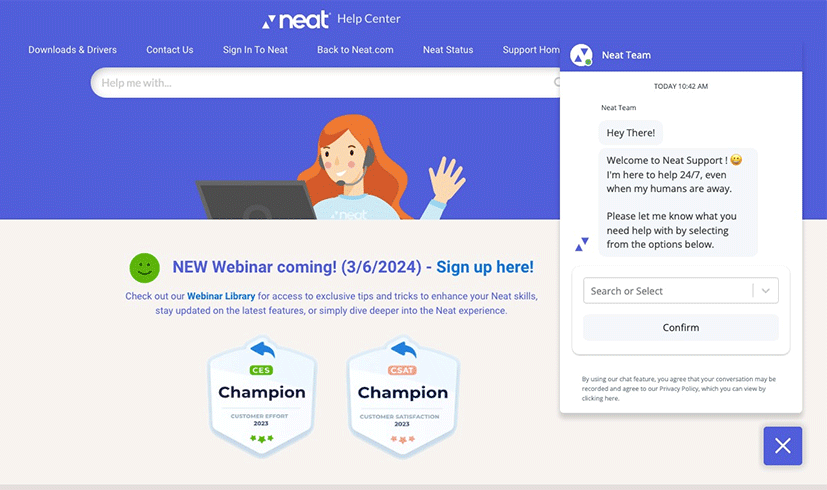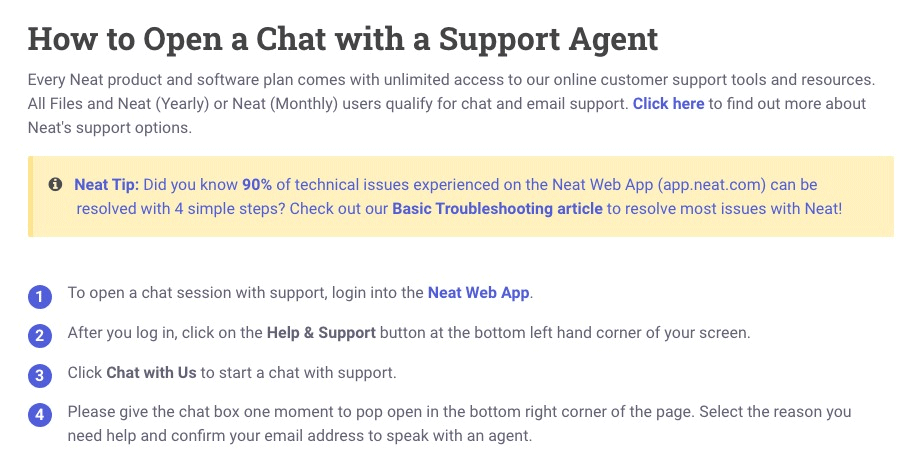According to SCORE, 40% of small businesses believe that customer experience helps retention and is their top growth strategy. At Neat, we definitely agree, which is why we believe in the importance of customer support.
“You’re only as good as your last customer interaction,” says Jeff Gove, VP of operations and information tech at Neat.
Gove has led the customer support efforts for almost eight years at Neat, and he has insights to share that you can apply to your own business. So sit back, and learn how you can make your customer support operations thrive.
Take a three-tiered approach to customer support
With customer support, it’s easy to get overwhelmed with the number of ways to connect with customers. But it doesn’t have to be complicated. According to Gove, taking a three-tiered approach to customer support is the single most cost-effective way to engage with your customers.
Here’s what those tiers look like:
- Tier 1: Solve the problem before it’s even an issue. Your product or service should be simple enough for the customer to understand without having to ask questions.
- Tier 2: If customers do have questions, provide answers front and center through blog articles, FAQs, and videos. These resources can be organized in a knowledge base on your website.
- Tier 3: If the customer can’t find the answer to their question via the sources above, offer a live connectivity option, such as email, phone, or live chat. Use their questions to improve Tier 1 and Tier 2 options.
“Say that a Neat customer is trying to set up books for tax reporting at the end of the year and doesn’t understand how to do it just based on the software,” Gove says. “We have a blog article right next to that page that they’re on within our application that says ‘here’s the best practices for tax preparation.’”
The customer can then watch a video or read the blog to understand how to complete their books. If that fails to solve the problem, the customer can contact a Neat live agent.
Use this three-tiered framework as you conduct any customer support activities. But Gove advises caution as you create these tiers. Technology can be a hindrance if you’re relying on it to do all the work. Continually check to make sure that your resources and live chat options are up to speed and that your tech is actually answering customer questions.
Make your product or service simple and easy to understand
Gove recommends making your product or service as simple and as easy to use as possible to reduce the number of questions a customer has on the front end. This insight goes back to Tier 1 of the three-tiered customer support approach. In short, get ahead of the problem.
Talk with your customers. Revisit past support conversations. Find out what customers currently struggle to understand about your product or service, and make changes as necessary.
Let’s say that you have a landscaping business that specializes in commercial locations, but maybe your website doesn’t clearly state this fact, so you’re constantly fielding calls from confused customers who want residential services. Before you ever spend time writing blog articles or setting up customer messaging, your website should clearly outline the specific services that you offer.
These product/service efforts improve the overall customer experience, as well as help you keep customers. A poor experience increases the risk that a customer will leave for good. More than half (51%) of customers actually say that they will avoid doing business with a company again after just one negative experience.
We believe in creating a positive customer experience at Neat and our intuitive software is a major part of that. “We strive to build simplicity into our software,” Gove says. “We look at it from the customer’s perspective. So, not just what are the features and functionality and how do they work, but how is the customer going to utilize this?”
Meet the customer on the channels they use
Fifty-nine percent of customers have used three or more channels to get their questions answered. In short, customers expect to be able to contact you on their preferred channels.
If you aren’t able to correct your product (Tier 1), or the customer can’t find the answers to their questions through FAQs or articles (Tier 2), provide a multichannel experience. This experience can be a mix of preferred customer-contact channels, such as phone, text, and live chat.
Research what channels your customers prefer. Cater to their choice for how they want to interact with you. Evolve with their preferences. The primary support channels at Neat used to be phone, web forms, and chat. We’re now 30-40% phone support and largely live chat.
These contact options and support capabilities are built right into our app. We made these changes three years ago to meet our customers where they are. “If a customer needed support, they had to go out to our website, go search our FAQ, or reach out for live support,” Gove says. “We’ve now put all of that into our cloud-based app. Customers get context-based FAQ news, so they can search very easily for what they need. If that still doesn’t work, then they have a live support options. ”
If you’re not sure which channels your customers prefer, send out an email with a quick survey to ask.
Use a variety of customer support success metrics
Once you’ve implemented your tiers, you’ll want to track your success. Within a customer support environment, Gove says there’s not a single metric that defines overall success.
Use a variety of metrics like customer effort score, net promoter score, and daily operational KPIs (e.g., wait time to get to an agent). By looking at customer support efforts from a broad spectrum of KPIs, you can get a solid grasp on your support organization and whether customers like or dislike what you’re doing.
In addition to net promoter score and daily operational KPIs, we’ve found the customer effort score to be a strong indicator of success. This score is simply a survey question that we ask after we’ve done a service interaction with a customer: How easy did we make it for you to get your issue resolved?
“We use a scale of one to seven — one being hell on earth and seven being the easiest process ever,“ Gove says.
Don’t be discouraged if you don’t see positive results right away. Follow the three-tier framework. Document problems that customers have, and find a solution so you don’t have to solve the same issue twice. Then, check your metrics to track your progress.
“Two years ago, we started out with a lower customer effort score, but it gave us something to strive for,” Gove says. “Over the last two years, we’ve reached a 6.2 average out of seven.”
Your customers are the lifeblood of your business — treat them well
A Walker study found that by the end of 2020, customer experience will overtake price and product as the key brand differentiators. It’s important to get your customer support running smoothly to both attract and retain customers.
“If you have a problem and you solve it, you’re going to have a stronger customer relationship,” Gove says. “If you have a problem and it continues to happen, the customer is going to go somewhere else.” Step up with your three-tiered approach and go above and beyond for customers.
Traditional bookkeeping activities can be a significant hindrance to your time spent on customer support. With Neat, you can use our dashboard to easily manage your bookkeeping tasks and focus on other strategic activities. Check out our free trial here.
Popular

March 31st, 2022

June 26th, 2020





